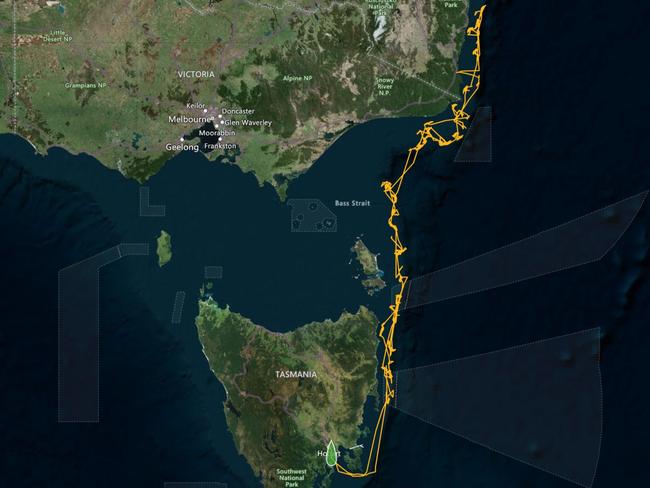RV Investigator arrives to Hobart after comprehensive voyage across South-East Australia
‘No other oceanographic study of the ecosystem has covered as much ground’: A RV Investigator voyage across south-east Australia looked to untangle the ocean’s big questions.

Tasmania
Don't miss out on the headlines from Tasmania. Followed categories will be added to My News.
Scientists and crew aboard a recent RV Investigator voyage through south-east Australian waters might have expected a creeping sense of isolation during their month-long mission to sea.
But the truth is, they were never alone.
Researchers shared the 6000km round trip with seabirds hitching a ride on the ship’s structures, and a rogue, four-kilogram octopus found lounging on the vessel’s back deck.

In between tallying the Investigator’s salty stowaways, marine biologists employed the latest technology to uncover a treasure trove of empirical riches both above and below the waves.
Voyage chief scientist, Dr Rich Little, said the third of four CSIRO South-East Australian Marine Ecosystem Survey journeys – which finished in Hobart on 12 December - had collected invaluable new information for what he described as a foundational study of global ocean health.

Reporting that the majority of the trip’s weather conditions had been “beautiful” for marine research, Dr Little said the data collated by his team would keep scientific analysts busy for years.
“We cracked the survey’s 380 species mark on this voyage, which included about 10 new species, which was exciting,” Dr Little said.
“We also saw a lot more species like pink snapper come up, as well as blue mackerel and small pelagics, and we saw a greater diversity of phytoplankton that the fish are eating.
“The water was very warm, and we were able to take temperature measurements in some of the really big whirlpools and eddies that were coming down.
“The water we sampled was at least three degrees higher than the long-term average … but which is consistent with temperatures over the last two or three years.
“We also conducted our first night trawl on this voyage, as an experiment for when we do that again in June when it will be a lot darker.
“No other oceanographic study of the ecosystem has covered as much ground as intensively as we have, and it has really set the standard for these types of surveys.”
While many of her research colleagues spent the trip in wet labs analysing fresh specimens brought aboard via trawl net, Dr Candice Untiedt kept her gaze aimed squarely on the ocean floor.

Using a high-definition camera towed deep behind the moving vessel, and second camera system attached to trawl net, Dr Untiedt captured still and video imagery of the diverse habitats at the bottom of the ocean and the unique fauna that live within them.
“We get the opportunity to look at the habitats inside Australian marine parks and other areas closed to fishing … to see the behaviour of animals,” she said.
“The cameras offer a really unique perspective of what these animals look like underwater, because they often don’t look the same when they come up.
“So this technology is particularly cool for taxonomists to have a look at what the fishes look like underwater, and where they live.

“But there’s never a voyage where we don’t find something exciting, and this time we had the opportunity to look inside Horseshoe Canyon, off Gippsland.
“The whole of the south east seafloor is covered in canyons, and in Horseshoe Canyon we found a really dense aggregation of stalked crinoids, which look like flowers, and are a very old species found in the fossil records from 480 million years ago.”
Dr Untiedt said the Investigator had additional advanced cameras operating above the waterline, with a system called Jonathan engaged in the real-time detection of sea birds.


The marine researcher described her involvement on the four-voyage ocean survey as a “once in a career opportunity”, and one that she felt privileged to belong to.
“It’s been amazing to work as part of this team and build on legacy data from 30 years ago to untangle all these really wicked problems the world faces,” she said.
Dr Little said the scientific mission’s purpose was to cover the same section of ocean as a similar survey undertaken 30 years ago, and compare the respective data sets for evidence of change in marine habitats or species.
“And then ask ‘is this climate change, or is it something else like bottom contact fishing’,” he said.
“Or is it both, and then try to untangle the effects of each of those on fish and the bottom community.”





